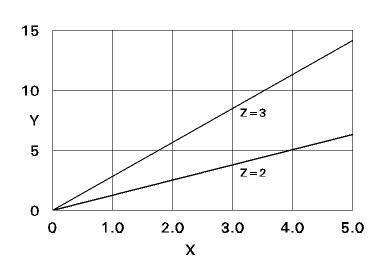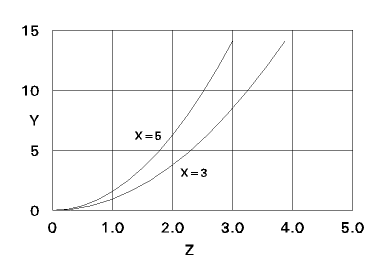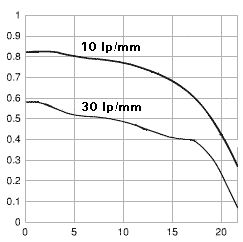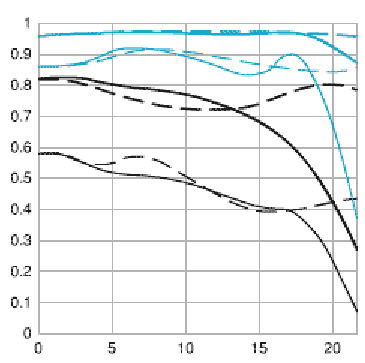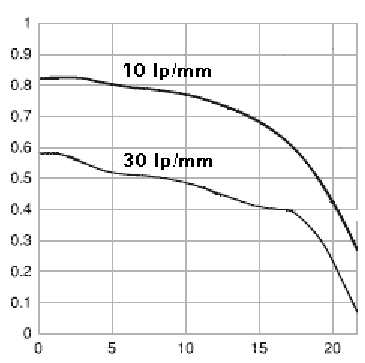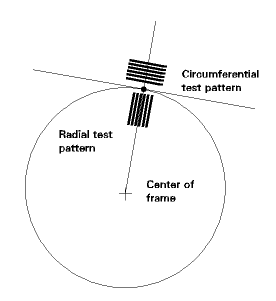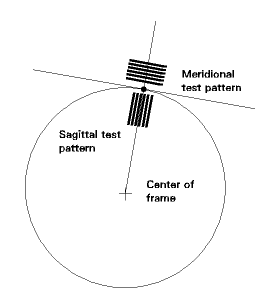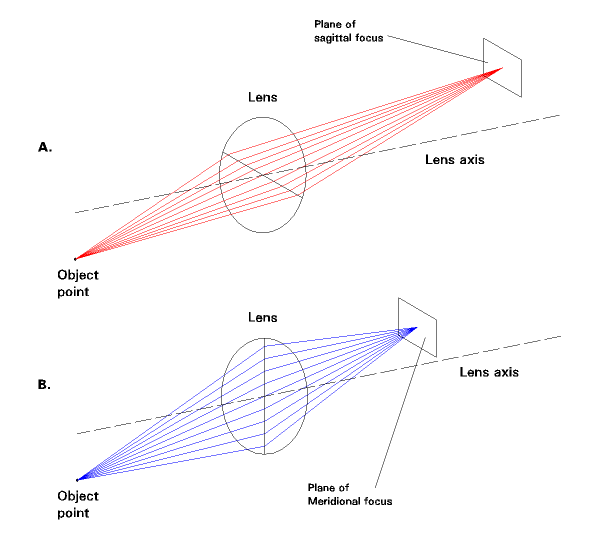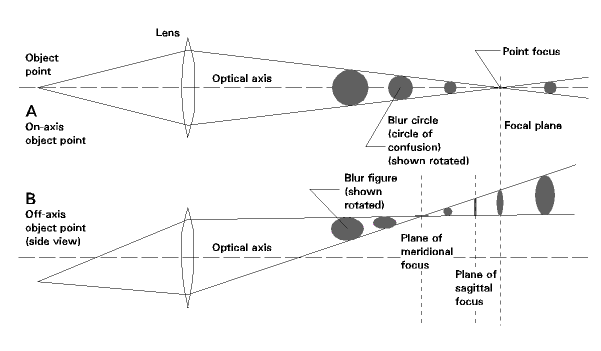Doug Kerr
Well-known member
We often see presented for a lens a set of curves described as the "modulation transfer function (MTF) curves for the lens. Here is an example, for the Canon EF 18mm f/1.8 USM lens:
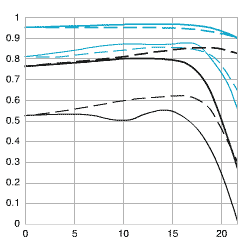
MTF curves for Canon EF 85mm f/1.8 USM lens
Courtesy of Canon , U.S.A.
These tell us several important things about the lens' optical performance - and in the form we normally see them, fail to tell us some other equally-important things.
I thought I would explain a little about the MTF curves. The tutorial will be in sections of hopefully-digestible size.
**********
THE MODULATION TRANSFER FUNCTION (MTF)
Part 1
Modulation
Here and in the rest of this article I will, to keep things a little simpler, assume the use of monochrome (black-and-white) photography.
In a scene, detail is conveyed by changes in luminance. If there were no change in luminance over a region, there would be no detail there.
In our context, the variation in luminance that constitutes detail is called modulation.
Imagine that we have detail that is a recurring pattern (perhaps stripes on a garment). If we survey that along a path across the stripes, we can quantity the degree of modulation (luminance change) by the property depth of modulation, which we can define this way:
ML = (Lmax-Lmin)/(Lmax+Lmin)
where ML represents the depth of modulation of the luminance, Lmax is the maximum luminance in the region, and Lmin is the minimum luminance in the region.
In the image on the sensor, the detail is conveyed by changes in the illuminance deposited by the lens
There, we can also define the depth of modulation in a similar way:
ME = (Emax-Emin)/(Emax+Emin)
where ME is the depth of modulation of the illuminance deposited on the image and Emax and Emin are the maximum and minimum values of the illuminance.
Conserving the modulation
Ideally, the pattern of illuminance deposited on the sensor by the lens would have, for any given small region, the same depth of modulation as we had in the scene luminance. But we never enjoy that ideal, for these reasons (among others):
• Flare and scattering in the lens allow some light bright parts of the image to flood other areas, diluting the depth of modulation.
• If the detail is fine (rapid changes in the luminance, and thus a high spatial frequency), the decline in resolution dilutes the depth of modulation. (For example, the "extinction resolution" of a lens is the spatial frequency at which the depth of modulation of the illuminance on the sensor has dropped to essentially zero.)
We can quantify the degree to which the lens "conserves" the original depth of modulation by using the ratio of the depth of modulation of the illuminance on the sensor to the depth of modulation of the luminance on the scene. We will call that for the moment the "modulation transfer ratio".
Its ideal (and highest possible value) is 1.0.
Modulation transfer ratio - a function of other factors
Even for a given lens, set to a given focal length (if a zoom), and a certain f-number, the modulation transfer ratio varies with (most notably):
• The spatial frequency of the modulation (the "fineness of the detail")
• The location on the frame (distance from the center).
Thus, we say that the modulation transfer ratio is a function of those two factors.
The specific way it varies could be described as the "modulation transfer ratio function".
The modulation transfer function (MTF)
When dealing with a function, mathematicians typically use the same name to describe both the relationship and the actual value of the result. (So you can see we are already set up for the possibility of confusion!)
In this case, the name used for both those things is "modulation transfer function." Thus that term means both "the modulation transfer ratio" (a very clear name that, sadly, we will not hear again) and "the way the modulation transfer ratio varies with other factors". We will mostly use it in the first sense.
[To be continued in Part 2]

MTF curves for Canon EF 85mm f/1.8 USM lens
Courtesy of Canon , U.S.A.
These tell us several important things about the lens' optical performance - and in the form we normally see them, fail to tell us some other equally-important things.
I thought I would explain a little about the MTF curves. The tutorial will be in sections of hopefully-digestible size.
**********
THE MODULATION TRANSFER FUNCTION (MTF)
Part 1
Modulation
Here and in the rest of this article I will, to keep things a little simpler, assume the use of monochrome (black-and-white) photography.
In a scene, detail is conveyed by changes in luminance. If there were no change in luminance over a region, there would be no detail there.
In our context, the variation in luminance that constitutes detail is called modulation.
Imagine that we have detail that is a recurring pattern (perhaps stripes on a garment). If we survey that along a path across the stripes, we can quantity the degree of modulation (luminance change) by the property depth of modulation, which we can define this way:
ML = (Lmax-Lmin)/(Lmax+Lmin)
where ML represents the depth of modulation of the luminance, Lmax is the maximum luminance in the region, and Lmin is the minimum luminance in the region.
In the image on the sensor, the detail is conveyed by changes in the illuminance deposited by the lens
There, we can also define the depth of modulation in a similar way:
ME = (Emax-Emin)/(Emax+Emin)
where ME is the depth of modulation of the illuminance deposited on the image and Emax and Emin are the maximum and minimum values of the illuminance.
Conserving the modulation
Ideally, the pattern of illuminance deposited on the sensor by the lens would have, for any given small region, the same depth of modulation as we had in the scene luminance. But we never enjoy that ideal, for these reasons (among others):
• Flare and scattering in the lens allow some light bright parts of the image to flood other areas, diluting the depth of modulation.
• If the detail is fine (rapid changes in the luminance, and thus a high spatial frequency), the decline in resolution dilutes the depth of modulation. (For example, the "extinction resolution" of a lens is the spatial frequency at which the depth of modulation of the illuminance on the sensor has dropped to essentially zero.)
We can quantify the degree to which the lens "conserves" the original depth of modulation by using the ratio of the depth of modulation of the illuminance on the sensor to the depth of modulation of the luminance on the scene. We will call that for the moment the "modulation transfer ratio".
Its ideal (and highest possible value) is 1.0.
Modulation transfer ratio - a function of other factors
Even for a given lens, set to a given focal length (if a zoom), and a certain f-number, the modulation transfer ratio varies with (most notably):
• The spatial frequency of the modulation (the "fineness of the detail")
• The location on the frame (distance from the center).
Thus, we say that the modulation transfer ratio is a function of those two factors.
The specific way it varies could be described as the "modulation transfer ratio function".
The modulation transfer function (MTF)
When dealing with a function, mathematicians typically use the same name to describe both the relationship and the actual value of the result. (So you can see we are already set up for the possibility of confusion!)
In this case, the name used for both those things is "modulation transfer function." Thus that term means both "the modulation transfer ratio" (a very clear name that, sadly, we will not hear again) and "the way the modulation transfer ratio varies with other factors". We will mostly use it in the first sense.
[To be continued in Part 2]

